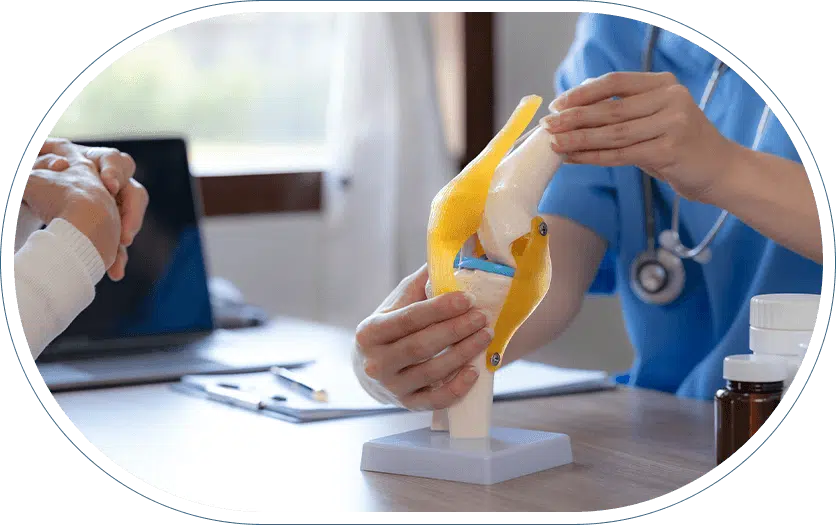Arthroscopic Surgery
The Centers for Advanced Orthopaedics Orthopaedic Associates of Central Maryland Division offers state-of-the-art arthroscopic surgery, or arthroscopy, performed by our board-certified, fellowship-trained orthopedic surgeons. Specializing in procedures for the elbow, hip, knee, and shoulder, arthroscopic surgery serves both diagnostic and reparative purposes for joint injuries and conditions. Our doctors specialize in arthroscopic knee surgery for a torn meniscus, arthroscopic shoulder surgery for a torn rotator cuff, and more.
Arthroscopic surgery, also known as arthroscopy, employs an arthroscope, a slender viewing instrument equipped with a lens and light, to guide surgeons during the procedure. This minimally invasive approach grants direct visualization inside the joint without the need for extensive incisions.
By utilizing arthroscopy, orthopedic surgeons can diagnose and treat conditions simultaneously, employing slender surgical instruments inserted through small incisions. Compared to traditional open surgeries, arthroscopic procedures offer numerous advantages, including reduced bleeding, diminished pain, lower infection risks, and accelerated recovery times.
Conditions We May Treat with Arthroscopy
Arthroscopy simply visualizes the joints through a camera. While diagnostic imaging like digital X-ray and MRI helps in diagnosing many soft injuries, arthroscopy allows us to diagnose and treat many hidden injuries as well. Below are some of the conditions for which we employ arthroscopy.
Anterior Cruciate Ligament (ACL) Tear
Arthroscopic surgery for the reconstruction of the ACL is a frequently performed procedure aimed at restoring knee joint function, stability, and preventing future injury.
In this surgery, the damaged ACL is replaced with a healthy tendon graft, sourced either from a nearby area of the knee or a donor cadaver. Through small incisions near the knee joint, the surgeon attaches the new graft using surgical hardware, resulting in a reconstructed ACL that enhances knee stability and function.
Impingement Syndrome
Shoulder impingement syndrome arises when the area beneath the acromion, a prominent bony projection at the end of the shoulder blade, becomes too restricted for the rotator cuff tendons to move freely. This constriction can result from structural irregularities in the shoulder bones, the presence of bone spurs, or thickened tissues.
Arthroscopic surgery offers a solution by enabling the surgeon to widen the space beneath the acromion, thereby facilitating unrestricted movement of the tendons. During the procedure, bone spurs, the anterior edge of the acromion, and the inflamed portion of the bursa may be removed, alleviating impingement symptoms and restoring shoulder function.
Meniscus Tear
The knee joint comprises two C-shaped cartilage discs known as menisci, which serve as shock absorbers during activities like walking or running and aid in the smooth movement of the knee. Meniscal tears often occur during forceful twisting movements of the knee.
Arthroscopic surgery is commonly employed for meniscus repairs, typically on an outpatient basis. The primary objective of surgery is to address the damaged portion of the meniscus while preserving the healthy tissue. Through small incisions, surgical instruments are introduced, allowing the surgeon to trim the torn segments of the meniscus and refine the remaining tissue using a surgical shaver.
Rotator Cuff Tear
Determining the necessity for surgery to address a rotator cuff tear usually relies on the severity of the damage. A complete tear often necessitates surgical repair. Various surgical techniques, including minimally invasive arthroscopy, are available.
Initially, your surgeon will create multiple small incisions around the shoulder joint. Through these incisions, an arthroscope and small surgical instruments are introduced to repair damaged muscles and reconstruct injured tendons using a graft tendon sourced from another area of the body. Additionally, if deemed necessary, your surgeon may remove damaged tissue and bone spurs from the rotator cuff during the procedure.
Benefits of Arthroscopic Surgery
Arthroscopic surgery offers numerous benefits compared to traditional open surgeries, making it a preferred option for many patients. Some of the key benefits include:
- Minimally invasive surgical treatment
- Reduced pain
- Faster recovery time
- Decreased risk of infection
- Improved visualization of the joint components
- Targeted treatment based on the injury
- Can be performed as an outpatient procedure
Overall, the benefits of arthroscopic surgery, including its minimally invasive nature, reduced pain, faster recovery, and improved outcomes with proper physical therapy, make it a highly desirable option for patients requiring joint surgery.
Arthroscopic Knee Surgery for a Torn Menisucs in Central Maryland
Are you ready to experience the benefits of arthroscopic surgery for your joint condition? Our board-certified orthopedic surgeons at The Centers for Advanced Orthopaedics Orthopaedic Associates of Central Maryland Division specialize in minimally invasive arthroscopic procedures for the elbow, hip, knee, and shoulder.
To schedule an appointment at one of our convenient locations in Columbia, Eldersburg, or Catonsville, Maryland, book online, get in touch via Klara messaging or call us directly. Call us at (410) 644-1880 or our toll-free at (855) 4MD-BONE. To get our physical therapy services, please call us at (443) 478-4449.



